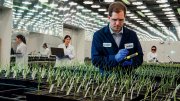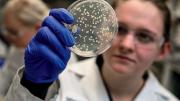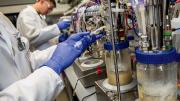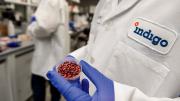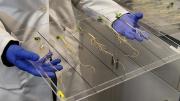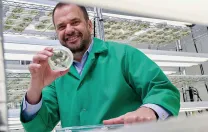By 2050, somewhere between nine and 11 billion people will be living on the planet. What will everyone eat? More than half the calories consumed by humans come directly from plants, mainly from grains such as rice, wheat, and corn. But agricultural yields of some of these row crops have already plateaued in a third of world. How to feed everyone—without degrading the environment—may be one of the great social problems of the next generation.
In absolute terms, the projected shortfall in staple grain crops by 2050 is immense—394 million too few tons of rice alone—and the path to higher yields uncertain. The situation invites comparison to the decades that followed World War II, when many countries could not grow enough food to feed their own people. As the global fertility rate set a pace that would lead to a doubling of population, from three to six billion, between 1960 and 1999, there was a Malthusian question to confront. Even with globalization, could the farmers of the world feed twice as many mouths? The answer in 1960 was clear: they could not—not without the help of a “Green Revolution.”
That revolution—championed by American agronomist Norman Borlaug, who was awarded the Nobel Peace Prize in 1970 for his work—led farmers to increase their use of chemical fertilizers, insecticides, fungicides, and herbicides; to adopt high-yielding crop varieties; to improve their irrigation practices and technologies; and to purchase machines for cultivating and harvesting their crops. Today, those practices are firmly entrenched facets of industrialized agriculture.
At the same time that these technologies have largely reached their potential, and their pitfalls have become more apparent, incomes have risen in the developing world, leading to preference-driven increases in demand for certain foods. In China, for example, as the population grew 41 percent between 1980 and 2015 and incomes soared far more, demand for pork quintupled, and demand for soybeans rose tenfold. Such shifts have global consequences. Brazil, an increasingly important exporter of soybeans to China, lost 9.5 percent of its forested land in conversions to “farming and other commercial purposes” between 2000 and 2014, according to a 2017 New York Times article chronicling the transformation of richly biodiverse Pantanal wetlands into soybean deserts. This in turn has contributed to substantial increases in Brazil’s greenhouse-gas emissions.
Globally, between a fifth and a third of total greenhouse-gas emissions have been attributed to agriculture, as has three-quarters of all deforestation. Pesticide-contaminated farm runoff (involving insecticides, herbicides, fungicides, and poisons for killing mites, rodents, snails, and slugs) pollutes fresh-water resources, while nitrogen and phosphate fertilizers can even poison the oceans, creating dead zones thousands of square miles in extent. People have begun to ask whether modern technology has a second act, one that would allow farmers to sustainably feed a peak population of 10 billion people without bumping into absolute limits in the availability of arable land and fresh water—not to mention the potential threats to cultivating food crops in a changing climate.
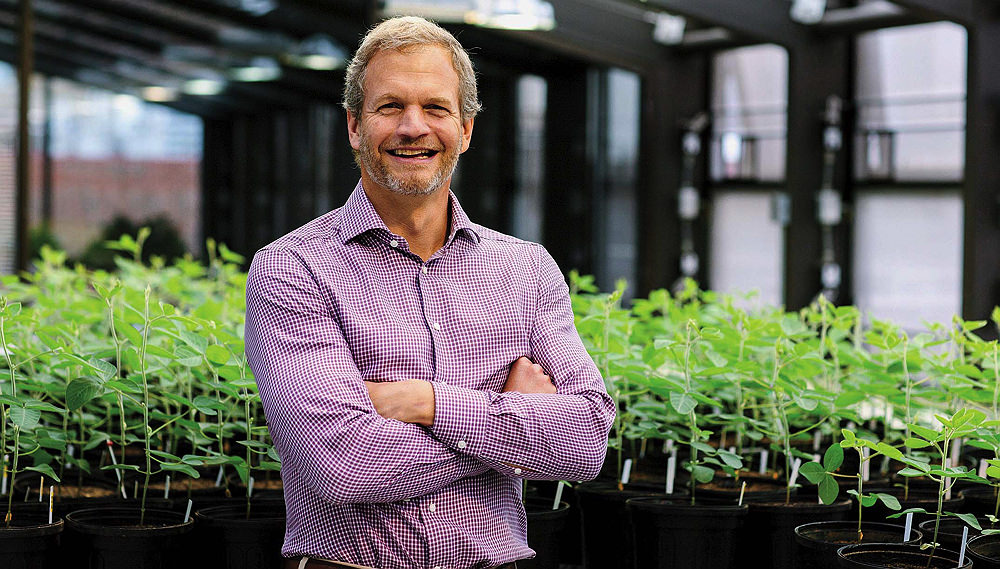
Indigo Ag CEO David Perry seeks a "better way" to do agriculture.
Photograph © Studio Nouveau/Courtesy of Indigo Ag
Innovators in new agricultural technologies say yes—the seeds of a new revolution are already growing. In the corporate sector, change is being driven by consumers in developed nations—thinking of their health, and the impacts of their food choices (see, for example, “Eating for the Environment,” March-April 2017, page 11)—and has been enabled by molecular biology, genomics, and information technology. Starting with major row crops, researchers have identified beneficial microbes that help plants grow, have edited plant genomes to improve them, and have pioneered ingenious solutions to reduce waste in the food-supply chain. These innovations could mark the beginning of a second Green Revolution—with the potential to help people in developing nations in Southeast Asia and Africa. And David Perry, M.B.A. ’97, the CEO of Indigo Ag, an agricultural-technology startup headquartered in Boston, believes that this time, these revolutionary changes will be better for everyone.
“In the 1940s we created industrialized agriculture for a good reason: we had to feed a whole bunch of people, and it worked,” he points out. “But the unintended consequences of that were technologies and methods that probably weren’t good for the environment, weren’t good for us as consumers, and arguably haven’t been very good for farmer profitability either. They end up spending all their money paying for those technologies”: chemical fertilizers and pesticides, expensive varieties of seed, giant tillers and combines.
Perry, who speaks with a hint of a drawl, knows about such things first hand. He grew up on a farm in Arkansas, where his family also sold fertilizer to their neighbors. After earning a chemical-engineering degree from the University of Tulsa, he worked at an oil refinery as an engineer for Exxon, then earned an M.B.A. from Harvard Business School. After running two successful startups, the second of which Pfizer ultimately acquired, he could have retired. Instead, he began searching for an opportunity that would allow him to work on a problem he cared about, and “that would make a positive difference in the world.”
That’s when he found Indigo Ag, a company that is commercializing microorganisms that help plants grow. Indigo Ag’s scientists have identified microbes that confer resistance to drought, and are developing others that reduce the need for chemical fertilizers and pesticides in five important row crops: corn, rice, soybeans, cotton, and wheat. They coat seeds with these beneficial microbes to reduce the need for irrigation, increase resiliency in drought-stressed plants, and enhance their ability to extract nutrients from the soil. Perry sees an opportunity for Indigo Ag to lead or catalyze a change in the way industrialized agriculture is done.
“I am conscious of what a big ambition that is,” he says. Agriculture is the largest industry in the world, employing a billion and a half people, “but there is a better way to do it than the way we are doing it right now.” Microbes have the potential to be a significant part of the solution.
The Anti-Darwinian Food Revolution
Awareness of the mutually beneficial relationships that plants maintain with microbes—both those in the soil and those, known as endophytes, that reside within their roots, shoots, leaves, and stems—has been growing during the past decade. In fact, scientists are just beginning to understand this anti-Darwinian world, based on evolution through cooperation, rather than competition. A recent article in Arnoldia, the journal of Harvard’s Arnold Arboretum, summarizes some of the research in this area, describing, for example, remarkable seasonal flows of nutrients between sugar maple trees and nearby trout lilies through underground mycorrhizal networks of symbiotic or mildly pathogenic fungi. Experiments in tomatoes and beans have demonstrated that plants can communicate the presence of pests through those same networks by releasing chemicals that then stimulate nearby plants of the same species to secrete protective chemicals. Oaks grown in a greenhouse and subjected to drought conditions have been shown to transfer water from their tap roots up through their root systems to associated fungal networks, sustaining these beneficial partners. The finding makes sense: some researchers believe that these fungal networks, not roots, are the principal way that plants extract nutrients from the soil.
Indigo Ag was founded to capitalize on the mutualisms among plants and their endophytic, in-plant microbial partners. When Perry joined the company as CEO in January 2015, it was “just 14 employees and the technology.” (It now employs nearly 250 people in four countries.) “But it was the most interesting combination of technology and unmet need I had ever seen,” he says, “because microbiology not only potentially addresses the yield problem, but does it in a way that is fundamentally healthier and more sustainable than current technologies.”
Identifying which microbes are beneficial to plants, though, presented a potentially gigantic screening challenge: a single gram of soil contains billions of microbes, and only a few play a role in plant biology. Perry calls Indigo Ag’s solution to that problem “probably the key to our early technical success, that allowed us to leapfrog everybody else.” One of the company’s most important scientific insights, he explains, “was that plants have already done this experiment for us. The ancestors of these plants have been growing in this soil for 200 million years. Every single one of them has sampled those microbes and evolved ways of incorporating the ones that are helpful and rejecting the ones that are potentially harmful. And so, we can leverage those 200 million years of experiments by just looking inside the plant….It is a super simple insight, but nobody else was thinking about it that way.”
Instead of dealing with billions of microbes, Indigo’s scientists were left with just hundreds of microbial associates within a plant. They began by collecting tens of thousands of plant samples, many of them crops, from every continent except Antarctica, and made sure to collect species growing in extreme environments, such as deserts, seeking to identify the microbiome of plants that can live under the most challenging conditions of drought and heat. Next comes DNA sequencing, to characterize the bacteria and fungi found in or on the specimens, and then machine learning to identify sequences likely to be beneficial, often sequences that resemble those the scientists have seen in association with other plant species growing under similar conditions.
These they test in plants. The greenhouses in the four-year-old company’s Charlestown, Massachusetts, headquarters cost $1.2 million—reflecting the need to control light, heat, and humidity identically for every plant in order to isolate the effect of the microbes being studied. Each quarter, Indigo Ag uses two-week lab assays to weed more than 1,000 candidate microbes per crop down to 100, followed by greenhouse assays to select the top 10 of that hundred for testing in the field. Once they have identified the bacteria and fungi that work best, they multiply them in a fermenter, scaling up in as little as four months from one to 2,500 liters of solution that can be used to coat seeds.
Their first product, Indigo Cotton™ (cotton seeds coated with their proprietary mix of microbes) was launched in the spring of 2016 in West Texas, and led to an 11 percent improvement in yield by protecting against drought stress. Now the company is buying their similarly treated crops—soy, cotton, rice, wheat, and corn—from growers at a premium based on improved quality of the harvest, as well as traceability and sustainability, and selling them to buyers who want those characteristics. In development are products that will reduce the need for nitrogen fertilizer, or confer pest protection. Eventually, Indigo Ag expects to “stack” its products, selling, for example, a drought-resistant corn that uses less fertilizer and also resists pests.
The potential appeal for farmers, whose costs in land, equipment, seeds, and fertilizer are all upfront, is enormous. “What they most want to avoid,” Perry explains, is “a down year that puts the farm at risk. So our ability to help these crops deal with extreme stress makes them profitable for farmers.”
Meanwhile, Indigo Ag has potential competitors, of two sorts. One is other startups, of which there are half a dozen, including NewLeaf Symbiotics in St. Louis and AgBiome in Durham, North Carolina, both “relatively small companies…doing good science,” Perry believes. The other potential rivals are big agricultural companies like Monsanto, Syngenta, and DowDuPont, which primarily sell seeds, chemicals, and fertilizers. “But you can imagine,” Perry says, “that if this is the next most important technology, they would have an interest in it.”
He doesn’t dismiss the possibility that Indigo Ag could be purchased by a large firm, and he takes seriously his responsibility to give investors the best possible return, but the company’s plans are explicit that “there is an opportunity to build a big independent company here, and that we are likely to have the biggest impact on the world if we remain independent.”
Perry defines Indigo Ag’s place in the big picture thus: “We need about 70 percent more food than we currently produce—or rather than we deliver—to feed 10 billion people. Some of that can be managed through reducing waste and changing eating habits, but we have got to produce a lot more—let’s says 50 percent more.” As much as half of that additional production, he believes, will come from microbiology. Furthermore, he adds, “I think ultimately we have the opportunity to replace at least half of the chemical fertilizer used and maybe 90 percent of the chemical insecticides and fungicides.”
As for the remainder of the projected yield shortfall, Perry suggests that 20 to 30 percent is likely to come from genetic enhancements of staple crops, and the final 20 or 30 percent from “digital ag.” “Every decision a farmer makes right now is suboptimal, because they don’t have enough information to make an optimal decision,” he declares. With a digital infrastructure that aggregated data from many farms, farmers could learn from one another and make data-based decisions about what crops to grow, what portfolio of seeds to use, and when and how densely to plant them, he says. Today, though, “These are decisions that farmers are more or less making based on myth and legend.”
Reconnecting Farmers to Consumers
Once there is enough food—and Perry believes that technological solutions will meet that need—people can begin to consider the healthiest and most sustainable ways to grow food, what land it should be grown on, and what land to set aside for other purposes. “The decisions are very different all of a sudden,” he points out. “And I think we are just entering an era where that is going to become the new reality.”
He is hinting at the engine behind much of the technological change—a movement that is slowly reconnecting consumers with farmers. For most of history, he explains, farmers knew exactly for whom they were producing food: “It was them, their families, and maybe a really tight-knit community.”
Industrialized agriculture, despite its benefits, broke that link, turning crops into commodities. “Farmers got paid by the bushel of wheat or corn, and it is just an economic reality that if you pay for volume, and you are not paying for nutrition, or quality, or production method, then those will be sacrificed in order to maximize volume,” he says. “That’s the nature of commoditization.” But increasingly, people care about how their food is produced. To the extent that consumers are willing to pay for those preferences, as they do with organic foods, Perry sees an opportunity to change the system for the better.
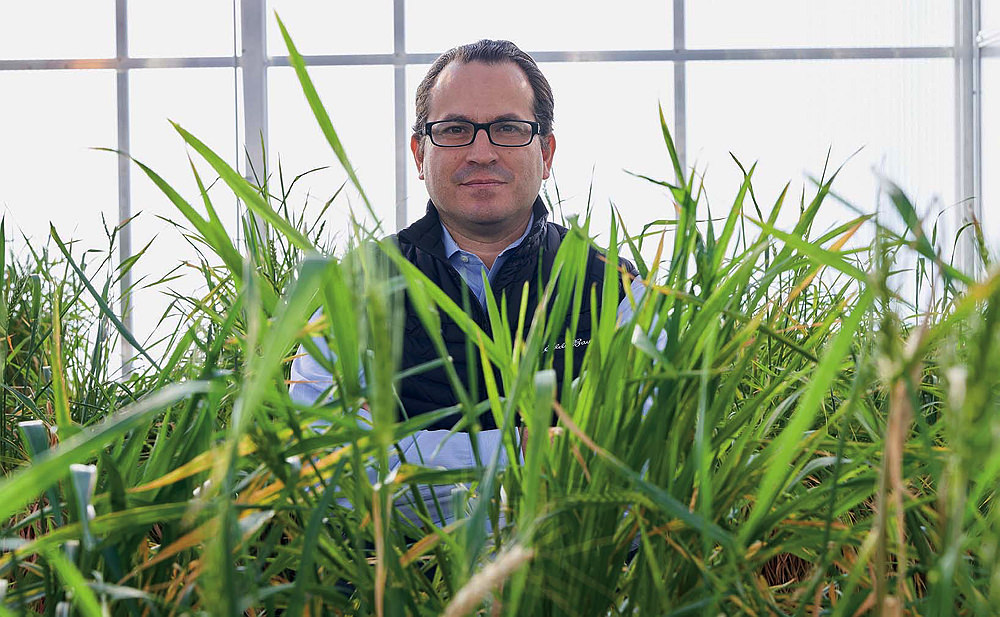
Calyxt CEO Federico Tripodi stands in the greenhouse at the company's new headquarters near Minneapolis.
Photograph by Thomas Strand
As consumers have become increasingly aware of the foods they eat, a disconnect has grown between their preferences and the commoditized agricultural supply chain that emphasizes low costs and efficiencies of scale, says Federico Tripodi, echoing Perry. As a consequence, supermarkets have begun to offer more brands and options, so that “large consumer-package companies have lost market share to small, nimble ones.” Tripodi is the CEO of Calyxt, a publicly traded specialty-foods company; like Perry, he sees in this disconnect a business opportunity. The two companies take different scientific approaches, however. Calyxt, rather than focusing on the plant’s microbiome, makes tiny edits in plants’ internal genomes in order to achieve a specific effect. The company’s first product is a soybean that produces high-oleic oil, a healthy fat—a notable coup as government regulations force a phaseout of trans fats from the food supply this year. Because Calyxt achieved its goal by deleting a few DNA base pairs among 1.2 billion, Tripodi likens it to “taking a book and deleting a word.”
The company plans to partner with farmers, agreeing in advance to buy the entirety of the altered soybean crop, and then arranging to extract and sell the healthy oil to major food producers. The flavorless, odorless oil contains zero trans fats and has 20 percent less saturated fat than traditional soybean oil, says Tripodi: characteristics that make it preferable to sunflower, canola, or olive oils for making products such as salad dressings, granola bars, or baked goods. Tests have also shown, he adds, that when used for commercial frying, the oil resists polymerization, so it remains stable longer in fryers.
Ultimately, Tripodi envisions a soybean that not only makes better oil, but has more protein and is herbicide-tolerant. “Maybe we work on some environmental traits that help farmers be more productive growers, and combine everything together. That’s what I think is going to happen in the next five to 10 years—a general improvement in the quality and environmental footprint of our target crops.”
TALEN®, the technology for making such edits, was invented by Daniel Voytas ’84, Ph.D. ’90, Calyxt’s chief scientific officer, and colleagues at the University of Minnesota, where Voytas, a world-renowned expert in the biology of plants, directs the Center for Genome Engineering (see “Engineering Superior Photosynthesis”). In practical terms, the edit TALEN made possible in soybeans is the kind of change that could occur with a single random mutation, or that could be bred into a plant in five to 10 years by traditional hybridization, he explained during an interview at Calyxt’s New Brighton, Minnesota, headquarters. The soybean plant already makes the desirable oil—the change made by Calyxt merely prevents it from converting the high-oleic oil into a less desirable linoleic form. And because this change does not involve the introduction of foreign genes from an unrelated species (transgenes), the U.S. Department of Agriculture does not consider the new variety a conventional genetically modified (transgenic) organism (GMO). The product can be planted anywhere without worry that it might introduce new genes into the natural environment.
Voytas points out that Calyxt’s initial products, including a high-fiber white flour that would bring the benefits of whole grain to white bread, are focused on the consumer. “Up to now, biotech has just been focused on the farmer,” he explains, as companies like Monsanto and DowDuPont engineered herbicide-tolerant, pathogen-resistant, or high-yield varieties of seeds for sale. Now, he says, there are “big consumer trends that could be met by genetically editing crop plants” to create healthier food products. “What’s cool about plants is that we have learned a lot in the past 15 to 20 years about how their genomes function to dictate various traits. Now, we can go in and start to tweak them.”
Voytas has horticulture in his own genes. His father worked for the U.S. Forest Service, and he’s been an avid gardener and reader of horticulture magazines himself since he started a business selling bedding plants as a boy. He arrived at Harvard as a freshman hoping to study plant biology, but the closest class he could find was a graduate-level course in plant taxonomy, which he took instead. He went on to develop a strong interest in molecular biology, then in its infancy, and pursued that during his doctoral studies with Harvard Medical School professor of genetics Frederick Ausubel, who has worked extensively with Arabidopsis thaliana (mustard weed), a model organism that was the first plant genome ever sequenced (see “Simple Hosts,” January-February 2003, page 48—read an online version here or find the original with images here).
The co-invention of TALEN came much later, in 2009. Although there are now other methods for editing genes, TALEN retains some advantages: Voytas has become proficient at targeting specific sites in plant genomes, and has helped build a large portfolio of intellectual property around TALEN and its use in plants. (The University of Minnesota has licensed TALEN to Cellectis, Calyxt’s parent company, which has already used it to cure two instances of childhood leukemia and plans to create off-the-shelf immunotherapies for the disease.)
Although Calyxt’s initial focus is consumer markets, Voytas has also developed several other products that target farmers and middlemen in the supply chain. An improved potato, for example, lasts longer in cold storage and, when cooked using high-heat oil, produces less acrylamide, a potential carcinogen. He achieved this by turning off a single gene that causes the potato to turn sucrose into glucose and fructose when exposed to cool temperatures.
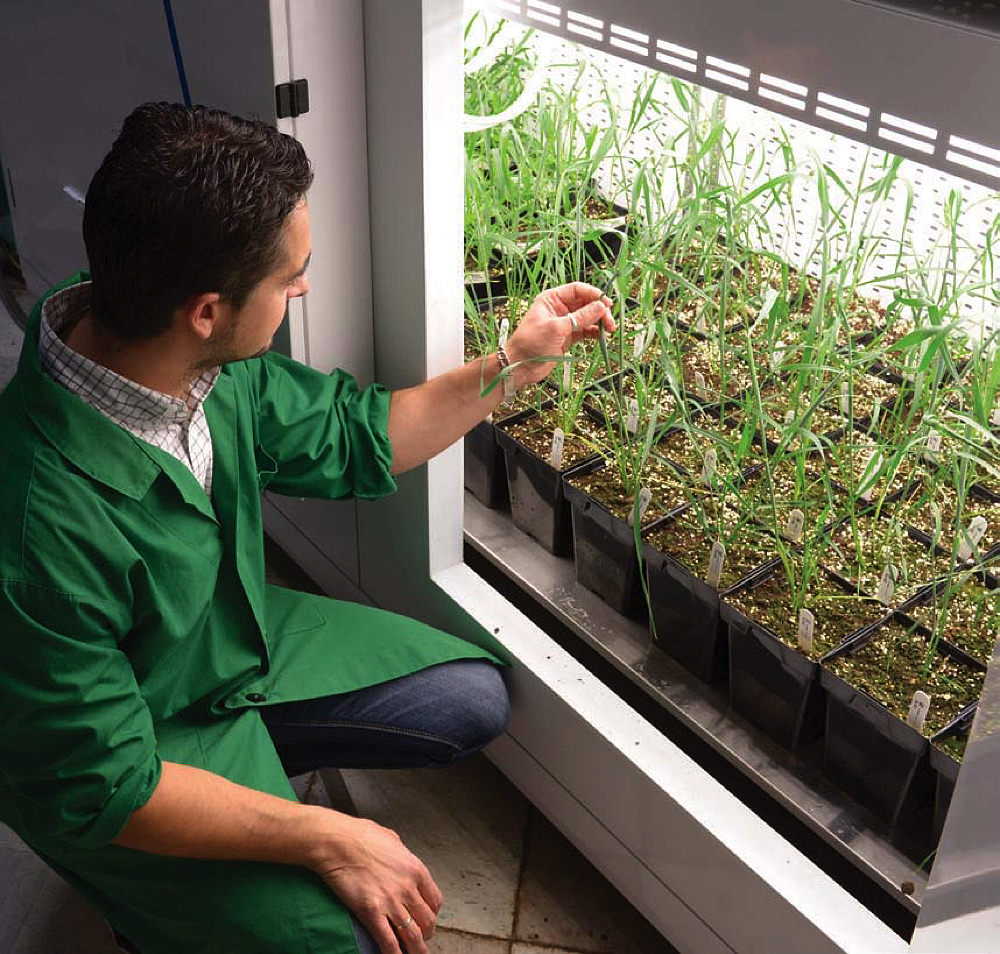
A lab technician checks on the company's high-fiber wheat plants.
Photograph courtesy of Calyxt
And Voytas has been working with wheat to develop varieties with traits that confer resistance to both fungal diseases and herbicides. Wheat is particularly challenging to modify, he explains, because its genome is huge: 17 billion base pairs, compared to about 3.5 billion for corn (and humans). In addition, wheat is hexaploid, carrying six copies of its genome (humans carry two, one from each parent). Furthermore, commercial wheat varieties are sexually compatible with wild North American species. That means that if a seed company started selling GMO wheat, the pollen could affect wild species and lead to “gene flow” (which is one reason why no GMO wheat is currently being grown commercially in the United States). Voytas is developing wheat varieties that have no foreign DNA, can tolerate two different herbicide chemistries (which kill weeds, but not the crop), and produce pollen that won’t transmit herbicide tolerance characteristics to wild relatives—a feat he achieves by selectively editing just a few of the plant’s six genomes. Ultimately, all these traits, whether desirable to consumers or farmers, can be stacked, he explains: because each is controlled by a separate biological pathway, they can be combined in a single seed variety.
A Revolution to Live With
The previous Green Revolution came with trade-offs. A new one may not require the same kinds of compromises. Perry, for his part, is optimistic that new technologies focused on the health and productivity of plants will lead to an agricultural system that is better for the environment, better for humans, and better for farmers. “That is what I got into this for,” he says. “If we can solve those things, the positive impact on the world would be enormous.” Agriculture already uses 70 percent of the world’s fresh water. Fertilizers have led to chemical pollution of aquatic environments and soil degradation. “Roughly a third of greenhouse-gas emissions come from agriculture or the products that are ultimately consumed by agriculture,” Perry says. Most of the people who live in poverty today are among the billion and half people who work in agriculture. “Those three goals—of improving human health, of improving environmental sustainability, and making farming a living wage—are three of the most important things I think we can do.” Companies like Indigo and Calyxt are not going to do that on their own, he acknowledges, “But we have got a shot at playing a really significant role.”
